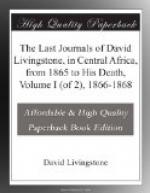29th July, 1867.—Went 2 1/2 hours west to village of Ponda, where a head Arab, called by the natives Tipo Tipo, lives; his name is Hamid bin Mahamed bin Juma Borajib. He presented a goat, a piece of white calico, and four big bunches of beads, also a bag of Holcus sorghum, and apologised because it was so little. He had lost much by Nsama; and received two arrow wounds there; they had only twenty guns at the time, but some were in the stockade, and though the people of Nsama were very numerous they beat them off, and they fled carrying the bloated carcase of Nsama with them. Some reported that boxes were found in the village, which belonged to parties who had perished before, but Syde assured me that this was a mistake.
Moero is three days distant, and as Nsama’s people go thither to collect salt on its banks, it would have been impossible for me to visit it from the south without being seen, and probably suffering loss.
The people seem to have no family names. A man takes the name of his mother, or should his father die he may assume that. Marriage is forbidden to the first, second, and third degrees: they call first and second cousins brothers and sisters.
A woman, after cupping her child’s temples for sore eyes, threw the blood over the roof of her hut as a charm.
[In the above process a goat’s horn is used with a small hole in the pointed end. The base is applied to the part from which the blood is to be withdrawn, and the operator, with a small piece of chewed india-rubber in his mouth, exhausts the air, and at the proper moment plasters the small hole up with his tongue. When the cupping-horn is removed, some cuts are made with a small knife, and it is again applied. As a rough appliance, it is a very good one, and in great repute everywhere.]
FOOTNOTES:
[50] It subsequently proved to be the southern extremity of this great Lake.
[51] Elais, sp.(?).
[52] This is a common symptom—men will suddenly lose all power in the lower extremities, and remain helpless where they fall.—ED.
[53] The men heard in 1873 that he had been killed.
[54] This comes near to the custom of throwing rice after the bride and bridegroom in England.—ED.
[55] In his Journal the Doctor writes “S,” and occasionally “Service,” whenever a Sunday entry occurs. We may add that at all times during his travels the Services of the Church of England were resorted to by him.—ED.
CHAPTER IX.
Peace negotiations with Nsama. Geographical gleanings. Curious spider. Reach the River Lofu. Arrives at Nsama’s. Hamees marries the daughter of Nsama. Flight of the bride. Conflagration in Arab quarters. Anxious to visit Lake Moero. Arab burial. Serious illness. Continues journey. Slave-traders on the march. Reaches Moero. Description of the Lake. Information concerning the Chambeze and Luapula. Hears of Lake Bemba. Visits spot of Dr. Lacerda’s death. Casembe apprised of Livingstone’s approach. Meets Mohamad Bogharib. Lakelet Mofwe. Arrives at Casembe’s town.




